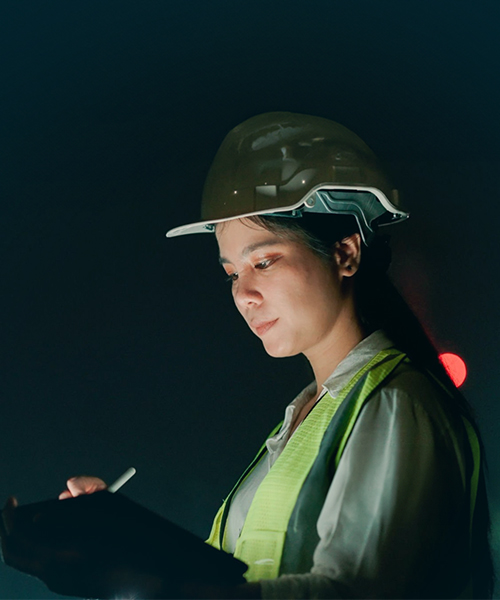February 28, 2024 • 5 min read
How will digital solutions impact decarbonizing industries in 2024?
Paul Hodson discusses the trends, challenges, and impacts of digital technologies on energy, chemicals and resources workforces

“2024 is shaping up to be a foundational year for niche technology skills,” says Hodson. “We’re going to see generative artificial intelligence (AI) take on more generalist and repeatable tasks. This will change the way our customers work and shift the focus of the workforce to more specialist skills and tasks that need human input.”
So, as these new ways of working emerge, what trends does Hodson anticipate across the energy, chemicals, and resources workforces in 2024?
Digital will play a greater role addressing skills shortages
As Hodson explains, one of the immediate challenges in the energy, chemicals and resources sectors is the global shortage of skilled labor required to transition to more sustainable facilities.
“The competition for skilled professionals goes beyond a single industry, including sectors such as oil and gas, mining, and new energy. The problem is, these skills shortages can slow down or even halt otherwise viable projects to decarbonize facilities.
“However, this is starting to change,” continues Hodson. “I expect to see the beginning of the long anticipated ‘human machine’ era, with traditional roles such as healthcare workers, educators, and manufacturing employees working alongside AI, virtual reality (VR) and robotics technologies at scale.
“Digital technologies such as generative AI can help address the people shortage by automating routine tasks and providing real-time feedback and guidance. This can help make people more efficient in their roles, and also help to cover more generalist roles that companies are struggling to fill and that may be slowing projects,” says Hodson.
These technologies can support the workforce and accelerate the development of the next generation of skilled workers that will need to deliver new infrastructure much faster than any generation before them.
“These technologies will serve as valuable learning tools, offerings hands on experience. If we can familiarize new generations with what it’s like to use a digital twin, they’ll be able to use this knowledge for the rest of their careers,” he says.
Digital will help improve safety, reduce costs, and improve efficiency
As the energy, chemicals, and resources sectors adopt more advanced digital technologies, how will workforces adapt this year?
The workforce will be further augmented by robotics, particularly across fabrication and asset operations. Mixed human plus robotic worker environments will start to become more common.
By combining the strengths of human ingenuity and robotic capabilities, these environments can change how our customers’ facilities work.
“Human workers can focus on higher value tasks that require creative problem solving – and strategic thinking – leaving repetitive and demanding physical tasks to robots,” he says.
Hodson also believes the industry will begin to explore modular asset designs, with the option to design for robotics from the beginning of a project.
“Companies will adopt new approaches to asset design, prioritizing robotics enabled models to improve efficiency, safety and return on investment,” he says. “By integrating advanced robotics into their operations, they can also significantly reduce the number of personnel required on site, resulting in a reduced risk of incidents,” he explains.
Hybrid competencies will create solutions faster and more affordably
This new dynamic will reward professionals who can bring a blend of traditional industry knowledge and digital competence, by using data analysis and integrating technologies such as robotics.
“Think of a petroleum engineer who can optimize oil and gas production, but also structure data to be used by AI to improve asset performance,” says Hodson. “Or imagine a plant maintenance engineer with robotics expertise, seamlessly integrating these technologies into facilities. Or a telecommunications savvy miner could play a key role in the deployment of autonomous mining systems.”
By embracing and training a new generation of multi-skilled professionals, the industry can also improve sustainability performance.
“For example, integrating advanced digital tools – such as predictive analytics and AI – with problem solving abilities and years of engineering experience, can help optimize energy consumption in manufacturing processes, reducing CO2 emissions.”
However, the shift to hybrid engineering and digital skills may place pressure on the skilled workforce market over time.
“As it becomes easier to build basic applications, industries will enjoy fit-for-purpose tools and solutions at a fraction of the cost,” says Hodson. “This may create a demand shift from traditional engineering or digital skills to hybrid engineering or digital skills. This will particularly reward those who adapt by learning a mix of technical and digital skills.
“As a result, it’s going to be important to prioritize upskilling and reskilling, to ensure the workforce remains competitive and that people continue to grow at work.”
Digital will play a greater role in asset design
Hodson believes collaboration between the industrial value chain, academia, and governments need to grow this year, to revolutionize the design, construction, and operation of industrial assets.
Advanced technologies such as generative AI and photorealistic gamified digital twins can help with creating modular designs, optimizing construction processes, and finding the best ways to integrate robotic solutions.
“This year, it’s important for energy, chemicals and resources producers to explore how to leverage the expertise of the new generation of students, who are well versed in gaming and digital twin simulations. And in particular, how they can accelerate the development of sustainable assets.
“The new generation of students, who are deeply immersed in the world of gaming, can offer unique perspectives for embracing digital twin simulations,” continues Hodson. “With the right guidance from industry experts and the support of governments to enable controlled physical prototyping, they can use their talents to create tools and systems to deliver and evaluate projects faster.”
Digitalization in 2024 and beyond
Hodson believes the time is right to explore how digital can streamline processes, improve safety performance, optimize resource utilization, and accelerate progress on decarbonization goals.
“I picture a future where humans and machines collaborate like never before, to develop facilities faster and run them more efficiently. The goal is not to replace human input with robots or automation technologies. It’s to free up and upskill people to work on higher value challenges in the energy transition that need unique human input and problem solving skills.
“It’s crucial for energy, chemicals, and resources producers to embrace digitalization projects, not as mere optional upgrades, but as essential tools to meet the expectations of all their stakeholders. And they need to start as soon as possible.”





